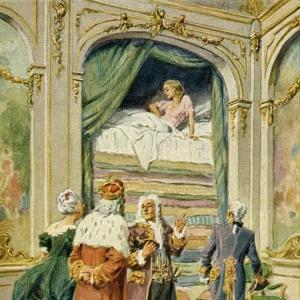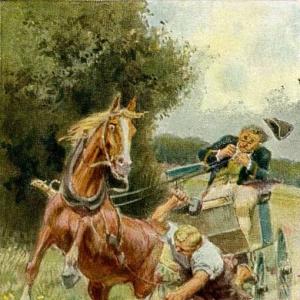Reading time: 3 min
„Where do you like best to feed your flocks?“ said a man to an old cow-herd. „Here, sir, where the grass is neither too rich nor too poor, or else it is no use.“ – „Why not?“ asked the man.
„Do you hear that melancholy cry from the meadow there?“ answered the shepherd, „that is the bittern. He was once a shepherd, and so was the hoopoe also. I will tell you the story. The bittern pastured his flocks on rich green meadows where flowers grew in abundance, so his cows became wild and unmanageable.
The hoopoe drove his cattle on to high barren hills, where the wind plays with the sand, and his cows became thin, and got no strength. When it was evening, and the shepherds wanted to drive their cows homewards, the bittern could not get his together again. They were too high-spirited, and ran away from him.
He called, „Come, cows, come,“ but it was of no use. They took no notice of his calling. The hoopoe, however, could not even get his cows up on their legs, so faint and weak had they become.
„Up, up, up,“ screamed he, but it was in vain, they remained lying on the sand. That is the way when one has no moderation. And to this day, though they have no flocks now to watch, the bittern cries, „Come, cows, come,“ and the hoopoe, „Up, up, up.“
 Learn languages. Double-tap on a word.Learn languages in context with Childstories.org and Deepl.com.
Learn languages. Double-tap on a word.Learn languages in context with Childstories.org and Deepl.com.Backgrounds
Interpretations
Summary
Linguistics
„The Bittern and the Hoopoe“ is a lesser-known fairy tale collected by the Brothers Grimm, Jacob and Wilhelm, who were German academics, philologists, and folklorists. They are famous for their collection of European folk tales and fairy tales, which include well-known stories such as „Cinderella,“ „Snow White,“ and „Hansel and Gretel.“ Their collection, titled „Grimms‘ Fairy Tales“ or „Children’s and Household Tales“ (originally „Kinder- und Hausmärchen“ in German), was first published in 1812 and underwent several revisions and expansions over the years.
The Brothers Grimm aimed to preserve traditional stories and cultural heritage while also creating moral lessons for their readers. Their fairy tales often contain elements of magic, enchantment, and fantastical creatures, along with themes of morality, justice, and the triumph of good over evil.
In „The Bittern and the Hoopoe,“ the titular characters are two birds: the bittern, a wading bird from the heron family, and the hoopoe, a colorful bird with a distinctive crest found across Afro-Eurasia. The story uses these birds as allegorical figures to illustrate the importance of moderation and balance in life. The tale is more simplistic and less fantastical compared to other Grimm stories, but it carries a valuable lesson in the consequences of extreme behaviors and the need for equilibrium.
„The Bittern and the Hoopoe“ can be interpreted in several ways, but the central theme revolves around the importance of moderation and balance in life. Here are a few interpretations:
The dangers of extremes: The story highlights the consequences of choosing either extreme: indulgence or deprivation. By tending to their flocks in environments that were either too rich or too poor, both the bittern and the hoopoe faced difficulties in managing their cows. This suggests that finding a middle ground is crucial for success and harmony.
The importance of balance: The tale serves as a reminder that striking a balance in various aspects of life is essential. Whether it’s work and leisure, personal and professional relationships, or emotional and physical well-being, maintaining equilibrium can lead to more fruitful outcomes.
Adapting to circumstances: The story also emphasizes the need to adapt to one’s surroundings and make informed decisions. The bittern and the hoopoe failed to adjust their grazing techniques based on their environments, which led to negative consequences for their flocks.
The persistence of past mistakes: The fact that the bittern and the hoopoe continue to cry out their commands long after losing their flocks suggests that past mistakes or regrets can continue to haunt us. Learning from these experiences and embracing the lessons they teach can help individuals grow and prevent similar missteps in the future.
Overall, „The Bittern and the Hoopoe“ is a cautionary tale that underscores the value of moderation and balance in life, reminding readers to avoid the pitfalls of extreme behaviors and seek harmony in their choices.
„The Bittern and the Hoopoe“ is a fairy tale by the Brothers Grimm that conveys the importance of moderation. The story begins with a man asking an old cow-herd where he prefers to graze his cattle. The cow-herd responds that he likes a place with grass that is neither too rich nor too poor, and then mentions the melancholic cries of the bittern and the hoopoe, who were once shepherds.
The cow-herd explains that the bittern used to graze his flock on lush meadows filled with flowers, which caused his cows to become wild and unmanageable. On the other hand, the hoopoe chose to graze his cattle on high, barren hills with sandy terrain, resulting in his cows becoming weak and frail. When evening came, the bittern struggled to gather his spirited cows, calling out „Come, cows, come,“ but they ignored him. Meanwhile, the hoopoe found it impossible to get his feeble cows on their feet, despite yelling, „Up, up, up.“
The story concludes with the cow-herd stating that these cries can still be heard from the bittern and hoopoe to this day, even though they no longer have flocks to tend. The tale serves as a reminder of the importance of moderation and balance in life, as extremes can lead to unfavorable outcomes.
The fairy tale „The Bittern and the Hoopoe“ by the Brothers Grimm can be analyzed linguistically and thematically to uncover the deeper meanings and stylistic choices.
Dialogue and Direct Speech: The story opens with a conversation, a common technique in fairy tales to quickly introduce characters and context. It establishes a narrative frame, with the old cow-herd serving as a storyteller within the story. The direct speech („Where do you like best to feed your flocks?”) immediately involves the reader and gives voice to the characters.
Colloquial Language: The language used is simple and colloquial, accessible to a wide audience, including children. This reflects the oral tradition of fairy tales, where stories were told aloud and needed to be easily understood.
Repetition and Rhythm: The repeated phrases (“Come, cows, come” and “Up, up, up”) create a rhythmic quality typical of oral storytelling. This repetition emphasizes the futility of the shepherds’ actions and the consequences of their lack of moderation.
Personification and Anthropomorphism: Animals, in this case the bittern and the hoopoe, are given human characteristics, a common trait in fairy tales. This allows for the exploration of human follies and virtues in a metaphorical context.
Moral and Didactic Elements: The tale carries a clear moral about the virtue of moderation. The consequences faced by the bittern and the hoopoe serve as lessons about excess and deficiency. The story implicitly warns against extremes, suggesting that a balanced approach is more beneficial.
Imagery and Symbolism: The rich green meadows and the high barren hills symbolize the extremes of abundance and scarcity. These settings are not only physical spaces but also metaphorical representations of the shepherds’ choices and their respective downfalls.
Descriptive Language: Descriptions such as “rich green meadows” and “high barren hills” vividly set the scene, creating mental images that enhance the story’s message. The use of adjectives paints a clear contrast between the two environments, further highlighting the theme of moderation.
Symbolic Crying: The continued cries of the bittern and the hoopoe („Come, cows, come“ and „Up, up, up“) serve as haunting reminders of their past mistakes. This symbolic crying perpetuates the moral lesson, showing how actions have long-lasting consequences.
In conclusion, „The Bittern and the Hoopoe“ employs simple yet effective linguistic techniques to convey a timeless moral lesson. The use of dialogue, repetition, and imagery, combined with personification, creates an engaging story that resonates with audiences and imparts a clear message about the importance of balance and moderation in life.
Information for scientific analysis
Fairy tale statistics | Value |
|---|---|
| Number | KHM 173 |
| Aarne-Thompson-Uther-Index | ATU Typ 236 |
| Translations | DE, EN, DA, ES, PT, IT, JA, NL, PL, RU, TR, VI, ZH |
| Readability Index by Björnsson | 23 |
| Flesch-Reading-Ease Index | 90.4 |
| Flesch–Kincaid Grade-Level | 3.8 |
| Gunning Fog Index | 6.5 |
| Coleman–Liau Index | 7.4 |
| SMOG Index | 7.2 |
| Automated Readability Index | 3.4 |
| Character Count | 1.272 |
| Letter Count | 943 |
| Sentence Count | 19 |
| Word Count | 239 |
| Average Words per Sentence | 12,58 |
| Words with more than 6 letters | 25 |
| Percentage of long words | 10.5% |
| Number of Syllables | 293 |
| Average Syllables per Word | 1,23 |
| Words with three Syllables | 9 |
| Percentage Words with three Syllables | 3.8% |

 Facebook
Facebook  Whatsapp
Whatsapp  Messenger
Messenger  Telegram
Telegram Reddit
Reddit














